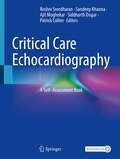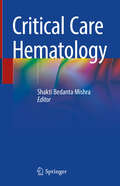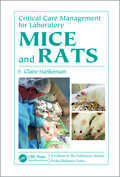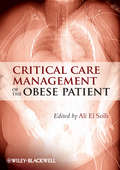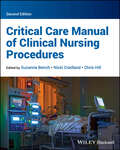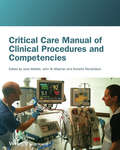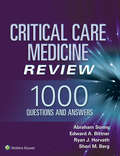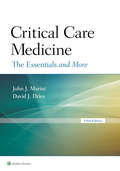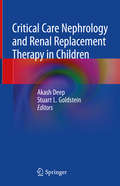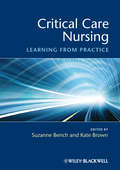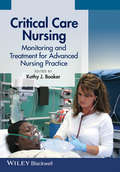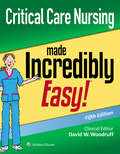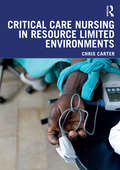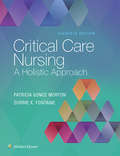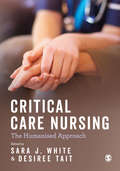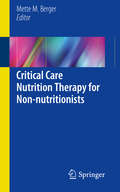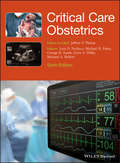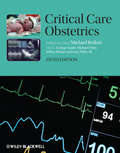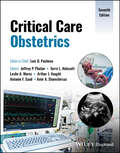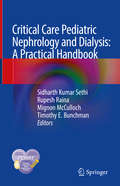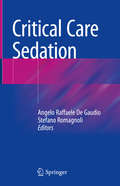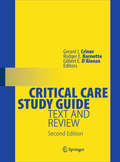- Table View
- List View
Critical Care Echocardiography: A Self- Assessment Book
by Patrick Collier Roshni Sreedharan Sandeep Khanna Ajit Moghekar Siddharth DugarThis book provides practice questions in a case-based format to prepare for the National Board of Echocardiography’s examination to assess “Special Competence in Critical Care Echocardiography”.Focused on the exam's core topics, this textbook caters to physicians who are preparing for the Critical Care Echocardiography board examination. Defining features of each chapter include case based scenarios with videos and supporting images, meaningful and relevant multiple-choice questions, key take-aways and a summary. This book is the product of a multidisciplinary collaboration between ICU physicians (Pulmonary, Internal Medicine and Anesthesiology), Cardiologists, and Anesthesiologists.This book meets the needs of physicians from various disciplines preparing for the critical care echocardiography board examination.
Critical Care Hematology
by Shakti Bedanta MishraThis book discusses the most recent evidence-based approach to hematological diagnosis and management in ICU. It elaborates on the hematological problems in critical care setup, from hematological malignancies to post-operative management of bone marrow transplants. The book also covers the interpretation of laboratory abnormalities, administration of various chemotherapeutic agents, and critical care management of various primary and secondary hematological issues. It explains how to handle different complications in the intensive care unit. Various coagulation tests and their interpretations, particularly point-of-care tests such as thromboelastography and ROTEM are also focused on. Critical Care Hematology will benefit practitioners and trainees in hematology and critical care medicine. The book's comprehensive coverage will provide readers with a holistic view of the appropriate approaches to hematology in the ICU. Also, the chapters provide a systematic approach to diagnosing and flowcharts to assist medical practitioners in making timely decisions amid their hectic duties.
Critical Care Management for Laboratory Mice and Rats (Laboratory Animal Pocket Reference)
by F. Claire HankensonFor critical care of laboratory rodents, there is a scarcity of sources for comprehensive, feasible, and response-oriented information on clinical interventions specific to spontaneous and induced models of disease. With the more complex cases that need critical care management, many treatment approaches to veterinary emergencies cannot be applied
Critical Care Management of the Obese Patient
by Ali A. El SolhThis book provides health professionals with sound clinical advice on management of the obese patient admitted into hospital. It addresses all aspects of the patient's care, as well as serving as a resource to facilitate the management of services, use of clinical information, and negotiation of ethical issues that occur in intensive care. As the number of obese patients in intensive care continues to grow, this book will serve as a comprehensive clinical resource for everyday use by both obesity specialists and emergency medicine physicians.
Critical Care Manual of Clinical Nursing Procedures
by Chris Hill Suzanne Bench Nicki CredlandCritical Care Manual of Clinical Nursing Procedures The second edition of Critical Care Manual of Clinical Nursing Procedures is a practical overview of essential procedures for the care of critically ill patients. Beginning with chapters outlining the current scope of critical care, the book adopts a systematic stage-by-stage approach from admission to discharge. At each stage, it provides insights into physiology, key procedures, and the relevant evidence base. Now fully updated to incorporate the latest research and best practices, this volume is poised to remain an indispensable resource for the next generation of critical care providers. Readers of the second edition will find: In-depth, beat-by-beat analysis of key procedures in critical careInterventions underpinned by the latest evidenceContent aligned with the National Critical Care Competency Framework and endorsed by the British Association of Critical Care Nurses Critical Care Manual of Clinical Nursing Procedures is ideal for nurses working in a critical care unit, nurses undertaking post-qualification specialist courses in critical care, or other healthcare professionals working as part of a critical care team.
Critical Care Manual of Clinical Procedures and Competencies
by Annette Richardson John Albarran Jane MallettThis manual is aimed at all healthcare practitioners, from novice to expert, who care for the critically ill patient, recognising that different disciplines contribute to the provision of effective care and that essential knowledge and skills are shared by all practitioners. It provides evidence-based guidelines on core critical care procedures and includes a comprehensive competency framework and specific competencies to enable practitioners to assess their abilities and expertise. Each chapter provides a comprehensive overview, beginning with basic principles and progressing to more complex ideas, to support practitioners to develop their knowledge, skills and competencies in critical care.
Critical Care Medicine Review: 1000 Questions and Answers
by Sheri Berg Abraham Sonny Edward A Bittner Ryan J. HorvathCovering all four critical care board exams (anesthesiology, surgery, internal medicine, and neurology), Critical Care Medicine Review: 1000 Questions and Answers prepares you for exam success as well as clinical practice in today’s ICU. This full-color, easy-to-use review tool provides challenging case studies, relevant images, multiple-choice board-style questions, rationales for correct and incorrect answers, and references for every question. Edited by instructors of anesthesia and critical care from Harvard Medical School and Massachusetts General Hospital, this comprehensive resource is an ideal study guide for critical care fellows, recertifying practitioners, and CCRNs.
Critical Care Medicine at a Glance (At a Glance)
by Richard M. LeachCritical Care Medicine at a Glance The market-leading at a Glance series is popular among healthcare students and newly qualified practitioners for its concise, simple approach and excellent illustrations. Each bite-sized chapter is covered in a double-page spread with clear, easy-to-follow diagrams, supported by succinct explanatory text. Covering a wide range of topics, books in the at a Glance series are ideal as introductory texts for teaching, learning and revision, and are useful throughout university and beyond. Everything you need to know about Critical Care Medicine… at a Glance! Critical Care Medicine at a Glance, Fourth Edition provides a succinct, accessible, highly illustrated introduction to the care of the critically ill patient. Designed for medical students, junior doctors and nurses alike, this authoritative revision guide covers the essential clinical, diagnostic, and therapeutic skills required to manage critically ill patients with a wide range of conditions in a variety of settings. Colour-coded chapters which contain concise explanatory text, applications to practice, and numerous high-quality photographs, illustrations, diagrams and tables. Fully revised to reflect current guidelines, changes in practice and recent medical innovations, this fourth edition includes expanded coverage of resus, sepsis, COVID-19, ECMO, dermatological emergencies, envenomation and other key conditions and procedures. Updated chapters incorporate current assessment methods used by medical schools and postgraduate training programmes, whilst additional ‘Pearls of Wisdom’ boxes and ‘Wise Owl Reading’ reference suggestions are integrated throughout to aid learning and comprehension. Allows rapid access to the knowledge and skills required to care for the acute and critically ill Covers a wide range of topics such as respiratory and neurological emergencies, arrhythmias, ventilation and intubation, trauma surgery and abdominal imaging Features contributions from leading critical care practitioners Provides normal values, reference ranges and treatment and monitoring guidelines for various critical care scenarios Includes practical case studies, revision questions and self-assessment tests with answers Contains several useful appendices, including information on pacemaker types and classifications Critical Care Medicine at a Glance, Fourth Edition is a must-have for medical students, junior doctors and nurses in intensive care and emergency medicine and those undertaking postgraduate exams. For more information on the complete range of Wiley Medical Education publications, please visit: www.wiley.com To receive automatic updates on Wiley books and journals, join our email list. Sign up today at www.wiley.com/email All content reviewed by students for students Wiley Medical Education books are designed exactly for their intended audience. All of our books are developed in collaboration with students. This means that our books are always published with you, the student, in mind. If you would like to be one of our student reviewers, go to www.reviewmedicalbooks.com to find out more. This book is also available as an e-book. For more details, please see www.wiley.com/buy/9781119605881
Critical Care Medicine: The Essentials and More (Year Bks. #34-3)
by John J. Marini David J. DriesPublisher's Note: Products purchased from 3rd Party sellers are not guaranteed by the Publisher for quality, authenticity, or access to any online entitlements included with the product. With a full-color design and concise, easy-to-read chapters, Critical Care Medicine: The Essentials and a Bit More covers the core elements of critical care, with a unique focus on the pathophysiology underlying clinical disorders and how pathophysiologic concerns affect treatment options. There is much here that’s new: brand-new content, expanded discussions, and more graphical elements than ever before. Chapters follow a consistent structural template, with discussions of diagnosis, instrumentation, treatment and management techniques, and more. Expertly and succinctly captures all the fundamentals of the field!
Critical Care Nephrology and Renal Replacement Therapy in Children
by Akash Deep Stuart L. GoldsteinThis book represents an invaluable resource for professionals for the diagnosis and treatment of acute kidney injury (AKI) in children and how to select and deliver the appropriate form of renal replacement therapy (RRT). Experts from all over the globe have come together to share their wide experience in the field of Critical Care Nephrology in children. Paediatric critical care nephrology is a complex and highly specialised field, presenting challenges and management strategies that are often quite distinct from those seen in adult practice. Therefore, it is high time to address all the topics in the field of critical care nephrology in children in a unique book which is the first of its kind. This book covers the basics as well as advances in the field of Critical Care Nephrology. Each chapter is dedicated to practical aspects of a particular topic elucidating various management decision points. Each chapter is also accompanied with algorithms, figures and protocols in tabulated format. Information on how to manage specific conditions are contextualized with relevant background anatomy, physiology and biochemistry and practical examples. At the end of the chapter, there are key learning points. Paediatricians, nephrologists and paediatric intensivists, as well as paediatric critical care and nephrology nurses in all countries will find this book an invaluable reference text.
Critical Care Nursing
by Kate Brown Suzanne BenchCritical Care Nursing: Learning from Practice takes a unique approach to critical care. Based around case scenarios that have the patient as the central focus, each chapter is constructed around an example of a critically ill patient with specific care needs. The chapters then go on to critically explore the knowledge and skills required to deliver expert care. This book looks at a range of critical care scenarios, including:The patient with acute lung injuryThe patient with feverThe patient with an acute kidney injuryThe patient with long term needsThe patient with increased intra-abdominal pressureThe Patient following cardiac surgeryEach chapter develops knowledge of the related physiology/pathophysiology, appropriate nursing interventions that are research/evidence based, technical skills, data interpretation and critical appraisal skills, enabling the reader to apply fundamental knowledge to more complex patient problems. Critical Care Nursing: Learning from Practice is an essential resource for practitioners faced with complex and challenging patient cases.
Critical Care Nursing
by Kathy BookerProviding an easy-to-use reference, Critical Care Nursing outlines best practice for the assessment, monitoring and treatment of critically ill adult patients. Each chapter includes research and evidence-based strategies for treating commonly-seen conditions.Initial chapters introduce ICU set-up and operation, the rapid response team, vitals measurement and shock management strategies. Subsequent chapters, structured by organ system, focus on care relating to specific organ function and dysfunction, including the respiratory, cardiovascular, neurologic, renal and gastrointestinal systems. Key information on monitoring for overdoses, special considerations in traumatic injury and end-of-life concerns is also included.Critical Care Nursing is a comprehensive and informative resource for experienced staff nurses and advanced practice nurses working with critically ill patients on ICUs, PCUs, transitional care units and within emergency care departments.
Critical Care Nursing Made Incredibly Easy! (Incredibly Easy! Series®)
by David W. WoodruffFeeling unsure about your critical care nursing skills? Time to gain some confident know-how, with the freshly updated Critical Care Nursing Made Incredibly Easy!®, 5th Edition. This friendly, fully illustrated guide offers clear, concise direction on treating numerous acute and life-threatening issues. Absorb current best practices on critical care basics and specialized areas such as advanced life support measures, multisystem trauma, and treating specialized needs. This is ideal guidance for students, nurses new to clinical care, and those preparing for the Critical Care (CCRN) certification exam.
Critical Care Nursing in Resource Limited Environments
by Chris CarterAll hospitals have critically ill patients, and their management depends upon the resources available. In many low income countries, critically ill patients may be admitted to a critical care unit; however, many are nursed on wards due to a lack of critical care beds or simply die before they reach the hospital. This book provides guidance on the unique situations for nurses working in these challenging environments, while considering ethical decision-making, providing appropriate services, and the types of patients admitted. Topics covered include: working in a resource limited environment; cultural awareness and international agendas; provision and access to healthcare services; ethical considerations in the context of resource limited environments; best practice and knowledge regarding rehabilitation, pain management, managing a major incident; relevant research concerning resource limited environments. Critical Care Nursing in Resource Limited Environments prepares readers to consider how best to utilise their skills and deliver safe patient care within a resource limited context. Each easy-to-read chapter provides core knowledge and relevant research, as well as useful ideas and solutions, with further reading sections to signpost readers to key international resources. This text provides practical ideas for nurses working in critical care and defence nursing, and acute areas in resource limited environments. It can also be used to support educational courses and pre-deployment training for nurses hoping to work in Global Health.
Critical Care Nursing: A Holistic Approach
by Patricia G. Morton Dorrie K. FontaineNow in its 11th edition, this classic text and reference maintains its popular holistic approach to the complexities of critical care nursing with ideal coverage, depth, and features to prepare student nurses to provide optimal care for critically ill patients and their families.
Critical Care Nursing: A Holistic Approach
by Paul Thurman Patricia Gonce MortonComprehensive, evidence-based, and expertly written, Critical Care Nursing: A Holistic Approach, 12th Edition, helps you confidently prepare today’s students for the highly specialized and complex challenges of critical care nursing practice. This trusted, must-have text integrates clear, concise writing, engaging resources, and a proven holistic approach to instill the clinical competence students need to care for patients who are critically ill and their families. More efficiently organized and easier to use than ever, the 12th Edition presents theory and principles within the context of practical application to streamline students’ transition to successful critical care practice.
Critical Care Nursing: the Humanised Approach (Transforming Nursing Practice Ser.)
by Desiree Tait Sara Jane WhiteTait and White provide a much-needed introduction to the complex field of critical care nursing for undergraduate and postgraduate students. Covering the essential aspects of critical care nursing, students are asked to consider the biopsychosocial triggers of critical illness, and are walked through a number of different patient scenarios. Reacting to the Francis Report and other inquiries into standards of care, Tait and White’s humanising approach to critical care places equal emphasis on the 'head, hand and heart' knowledge; evidence, technical and ethical. The book’s depth of clinical knowledge is built and cemented through extended case studies of critically ill patients with a variety of needs. This breadth, along with the author’s unique approach prepares students for courses and assignments in critical care, as well as preparing critical care nurses for clinical decision making and practice. A must-have for anyone studying or working in critical care nursing.
Critical Care Nursing: the Humanised Approach (Transforming Nursing Practice Ser.)
by Desiree Tait Sara J. WhiteTait and White provide a much-needed introduction to the complex field of critical care nursing for undergraduate and postgraduate students. Covering the essential aspects of critical care nursing, students are asked to consider the biopsychosocial triggers of critical illness, and are walked through a number of different patient scenarios. Reacting to the Francis Report and other inquiries into standards of care, Tait and White’s humanising approach to critical care places equal emphasis on the ′head, hand and heart′ knowledge; evidence, technical and ethical. The book’s depth of clinical knowledge is built and cemented through extended case studies of critically ill patients with a variety of needs. This breadth, along with the author’s unique approach prepares students for courses and assignments in critical care, as well as preparing critical care nurses for clinical decision making and practice. A must-have for anyone studying or working in critical care nursing.
Critical Care Nutrition Therapy for Non-nutritionists
by Mette M. BergerThis book offers a pragmatic approach to day-to-day metabolic and nutritional care based on physiological considerations. Due to the numerous controversial trials published in the last 15 years, there is no clear guidance for intensive care physicians regarding the metabolic and nutritional management of patients. This has resulted in a return to underfeeding and related complications in most ICUs worldwide as shown by the latest Nutrition Day data. Using a structured, logical approach, the book examines practical solutions for artificial feeding in complex areas of critical care (brain injuries, burns, cardiac failure, ECMO, intestinal failure, long term patient, renal failure, metabolic diseases, obesity, old patients) and discusses measurement of the results of metabolic interventions. It also includes dedicated chapters focusing on specific problems, in order to avoid complications. Critical Care Nutrition Therapy for Non-nutritionists is a valuable resource for all general ICUs and ICU subspecialties such as cardiovascular, neuro, gastrointestinal and burns ICUs.
Critical Care Obstetrics
by George R. Saade Michael A. Belfort Michael R. Foley Jeffrey P. Phelan Luis D. Pacheco Gary A. DildyA new edition of the proven guide to providing emergency care for mothers-to-be in acute medical distress Now in its sixth edition, Critical Care Obstetrics offers an authoritative guide to what might go seriously wrong with a pregnancy and delivery and explains how to manage grave complications. Written by an international panel of experts, this updated and revised edition contains the most recent advances in the field as well as recommendations for treating common complications such as bleeding, thrombosis, trauma, acute infection, airway problems and drug reactions in a pregnant patient. This important guide offers the information needed to enable the early-on recognition of life-threatening conditions and the use of immediate life-saving treatments in emergency situations. The techniques and procedures outlined help to maximise the survival prospects of both the mother and fetus. The authors offer an accessible text for any healthcare professional responsible for the care and management of pregnant women and their unborn children. Critical Care Obstetrics is a vital resource that: Contains a clear guide for early recognition of conditions which may prove life threatening Offers new information on Analgesia and sedation; Imaging and interventional radiology in pregnancy; Oxygen therapy; and Pulmonary hypertension Presents protocols for implementing life-saving treatments in emergency situations Written by international experts in emergency obstetric medicine Designed for use by obstetricians and obstetrician and gynecology trainees, Critical Care Obstetrics is the updated guide to the management of serious conditions in pregnancy and delivery.
Critical Care Obstetrics
by George R. Saade Michael A. Belfort Michael R. Foley Gary A. Dildy III Jeffrey P. PhelanCritical Care Obstetrics provides expert clinical guidance throughout on how you can maximize the chances of your patient and her baby surviving trauma.In this stimulating text, internationally recognized experts guide you through the most challenging situations you as an obstetrician are likely to face, enabling you to skillfully:Recognize conditions early-on which might prove life threateningImplement immediate life-saving treatments in emergency situationsMaximize the survival prospects of both the mother and her fetusThe fifth edition of this popular book will help you keep your composure in high risk clinical situations, making it an invaluable resource for any healthcare professional responsible for the care and management of pregnant women and their unborn children.
Critical Care Obstetrics
by Luis D. PachecoCritical Care Obstetrics Improve medical outcomes for both mothers and children with this essential guide For the first time in decades, maternal mortality rates are climbing in the United States. Factors including lack of access to prenatal care, un- or underinsured populations, rising rates of cardiovascular disease, and more combine to make pregnancy and childbirth more dangerous prospects. In this environment, the study of critical care obstetrics has never been more essential. Critical Care Obstetrics, Seventh Edition a fully updated guide to the medical management of serious conditions in pregnancy and childbirth. Beginning with basic principles, it surveys the potential serious complications occurring in pregnancy and delivery and the techniques and procedures for maximizing patient outcomes for both pregnant people and fetuses. This clear, accessible text promises to continue the essential work of earlier editions. Readers of the seventh edition of Critical Care Obstetrics will also find: Detailed protocols for implementing life-saving treatments in emergencies New chapters on topics including ECMO, antibiotics, and pneumonia Authorship by internationally renowned experts in emergency obstetrics Critical Care Obstetrics is ideal for working clinical obstetricians and for trainees in obstetrics and gynecology.
Critical Care Pediatric Nephrology and Dialysis: A Practical Handbook
by Sidharth Kumar Sethi Rupesh Raina Mignon McCulloch Timothy E. BunchmanThis book covers all key aspects of critical care in pediatric nephrology, including acute dialysis in sick children. It also provides detailed protocols for managing fluid and electrolyte balance and dialysis in children in intensive care.
Critical Care Sedation
by Angelo Raffaele De Gaudio Stefano RomagnoliThis book provides a comprehensive guide to delivering analgesia and sedation to critically ill patients for professionals and caregivers being involved in the management of these patients. It discusses and explains in detail the advantages and limitations of each drug and device using clear flowcharts, diagrams and tables. Furthermore, it explores the new drugs and - above all - new sedation delivery systems, particularly those for administering volatile anesthetics on ICUs. This book is a valuable and practical resource for anesthesists, intensivists and emergency physicians interested in sedation.
Critical Care Study Guide: Text and Review
by Gerard J. Criner Gilbert E. D'Alonzo Rodger E. BarnetteThe second edition of this best-selling study guide and text covers all aspects of critical care medicine. Written by a diverse group of physicians and health care personnel, it is of interest to all professionals who care for the ICU patient. The unique format includes key points highlighted in the margins for quick reference and self-assessment questions and answers at the end of each chapter. The text is supported by case studies, tables, and numerous illustrations that detail key procedures. The new edition has been revised substantially to reflect the most current research and guidelines, and new chapters have been added to make this the most practical and comprehensive study guide and text available today.
